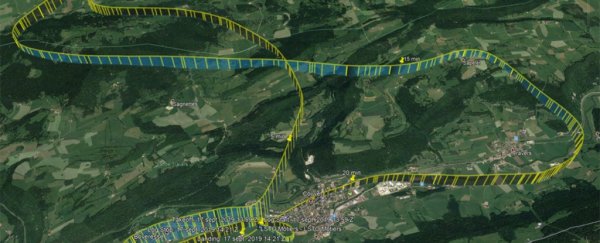
www.universetoday.com
We've Entered a New Era: The Lunar Anthropocene
For almost half a century‚ the term “Anthropocene” has been informally used to describe the current geological epoch. The term acknowledges how human agency has become the most significant factor when it comes to changes in Earth’s geology‚ landscape‚ ecosystems‚ and climate. According to a new study by a team of geologists and anthropologists‚ this same term should be extended to the Moon in recognition of humanity’s exploration (starting in the mid-20th century) and the growing impact our activities will have on the Moon’s geology and the landscape in the near future.
The study was conducted by Justin Allen Holcomb and Rolfe David Mandel‚ a Postdoctoral Researcher and a University Distinguished Professor with the Kansas Geological Survey at the University of Kansas (respectively)‚ and Karl William Wegmann‚ an associate professor with the Department of Marine‚ Earth‚ and Atmospheric Sciences and the Center for Geospatial Analytics at North Carolina State University. Their paper‚ “The Case for a Lunar Anthropocene‚” appeared in the December 8th issue of Nature Geosciences.
When it comes to the Anthropocene‚ one of the more contentious issues is defining when it began. Scientists have proposed dates ranging from the beginning of the Neolithic Revolution (ca. 12‚000 to 15‚000Â years ago) to the Industrial Revolution (1760 to 1840) and as recently as the mid-20th century. According to the authors‚ the Lunar Anthropocene can be traced to the arrival of the Soviet Luna 2 lander‚ the first human-made object to land on the lunar surface on September 13th‚ 1959. Since then‚ more than a hundred other spacecraft have reached the Moon‚ including six crewed missions (the Apollo Lunar Modules).
Illustration of light pollution caused by human activity (electric lights)‚ recreated using data from the Defense Meteorological Satellite Program (DMSP) and Operational Linescan System (OLS). Credit: NASA GSFC/NOAA NGDC
Thanks to the Apollo missions‚ 12 astronauts have walked on the surface of the Moon‚ conducted science experiments‚ and brought back samples of lunar rocks and soil. In the near future‚ multiple space agencies and their commercial partners will return‚ this time with the intent to stay. This includes NASA’s Artemis Program‚ the Russo-Chinese International Lunar Research Station (ILRS)‚ the ESA’s Moon Village‚ and other concepts that will lead to permanent infrastructure and a “sustained program of lunar exploration and development.”
According to the research team‚ humanity’s activities on the lunar surface and how they will expand considerably in the next few decades means it is time to acknowledge a new geological epoch for the Moon: the Lunar Anthropocene.
“The idea is much the same as the discussion of the Anthropocene on Earth — the exploration of how much humans have impacted our planet‚” said lead author Justin Holcomb‚ a postdoctoral researcher with the Kansas Geological Survey at KU. “The consensus is on Earth the Anthropocene began at some point in the past‚ whether hundreds of thousands of years ago or in the 1950s. Similarly‚ on the moon‚ we argue the Lunar Anthropocene already has commenced‚ but we want to prevent massive damage or a delay of its recognition until we can measure a significant lunar halo caused by human activities‚ which would be too late.”
Like Earth‚ scientists have divided the geological history into different epochs‚ each defined by the dominant forces shaping the landscape. These include the Pre-Nectarian‚ which spans from the initial formation of the Moon to the time of the Nectaris impact event – ca. 4.533 to 3.920 billion years ago (Gya). The Nectarian period follows‚ encompassing all events between the formation of the Nectaris and Imbrium impact basins (ca. 3.92 to 3.85 Gya). Then there’s the Imbrian period‚ divided into the early (3.85 to 3.8 Gya) and late (3.8 to 3.2 Gya).
Whereas the former coincided with the end of the Late Heavy Bombardment period‚ the latter is characterized by partial melting of the mantle below the lunar basins and filling them with basalt. Last‚ there are the Eratosthenian (3.2 to 1.1 Gya) and Copernican periods (1.1 Gya to present day)‚ which are defined by craters of a certain size being eroded by other impacts and the presence of bright ray systems surrounding impact craters. But with humans landing on the Moon‚ taking samples‚ and looking to establish settlements‚ impacts are no longer the main driving force for change.
Sample collection on the surface of the Moon. Apollo 16 astronaut Charles M. Duke Jr. is shown collecting samples with the Lunar Roving Vehicle in the left background. Credit: NASA
One of the benefits of recognizing this concept‚ said Holcomb‚ is that it might help dispel the myth that the Moon is an unchanging environment that has barely been affected by humanity:
“Cultural processes are starting to outstrip the natural background of geological processes on the moon‚” Holcomb said. “These processes involve moving sediments‚ which we refer to as ‘regolith‚’ on the moon. Typically‚ these processes include meteoroid impacts and mass movement events‚ among others. However‚ when we consider the impact of rovers‚ landers and human movement‚ they significantly disturb the regolith.
“In the context of the new space race‚ the lunar landscape will be entirely different in 50 years. Multiple countries will be present‚ leading to numerous challenges. Our goal is to dispel the lunar-static myth and emphasize the importance of our impact‚ not only in the past but ongoing and in the future. We aim to initiate discussions about our impact on the lunar surface before it’s too late.”
Recognizing the Lunar Anthropocene is also an opportunity to establish safeguards and protective measures to ensure humanity does not ruin the lunar environment. Currently‚ there is no equivalent of the “Campsite Rule” on the Moon‚ where campers are encouraged to leave no trace of their presence behind. As they state in their study‚ there is a serious risk that crewed missions to the Moon will leave refuse behind‚ including “discarded and abandoned spacecraft components‚ bags of human excreta‚ scientific equipment‚ and other objects (e.g.‚ flags‚ golf balls‚ photographs‚ religious texts).”
The presence of this refuse could impact the Moon’s tenuous exosphere and permanently shadowed regions (PSRs) where water ice can be found. Recent research has also examined the impact multiple takeoffs and landings could have on the local regolith‚ creating dust clouds that will take a long time to settle (due to the Moon’s lower gravity). This will not only be hazardous to spacecraft‚ vehicles‚ and habitats but could also have long-term consequences for conditions on the surface.
Orbital images of lunar landing sites. Credit: NASA/GSFC/ASU
While Holcomb and his colleagues hope this concept will highlight the potential for harm that human exploration and development could entail‚ they also hope it calls attention to the vulnerability of lunar sites with historical and anthropological value (like the Apollo Landing Sites). On Earth‚ places with immense historical and cultural significance are designated “Heritage Sites” and assigned legal protection by the United Nations Educational‚ Scientific and Cultural Organization (UNESCO). However‚ there is currently no equivalent for lunar sites.
Holcomb and his colleagues recommend a program for “space heritage” that would aim to preserve or catalog items left by humanity on the surface‚ such as rovers‚ flags‚ golf balls‚ and footprints:
“A recurring theme in our work is the significance of lunar material and footprints on the moon as valuable resources‚ akin to an archaeological record that we’re committed to preserving. The concept of a Lunar Anthropocene aims to raise awareness and contemplation regarding our impact on the lunar surface‚ as well as our influence on the preservation of historical artifacts.”
“As archaeologists‚ we perceive footprints on the moon as an extension of humanity’s journey out of Africa‚ a pivotal milestone in our species’ existence. These imprints are intertwined with the overarching narrative of evolution. It’s within this framework we seek to capture the interest of not only planetary scientists but also archaeologists and anthropologists who may not typically engage in discussions about planetary science.”
Further Reading: University of Kansas
The post We've Entered a New Era: The Lunar Anthropocene appeared first on Universe Today.

 Rumble
Rumble















